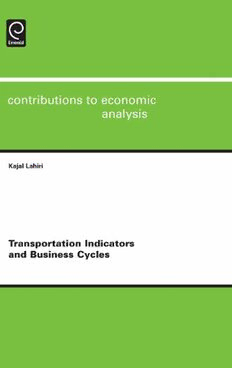
Transportation Indicators and Business Cycles PDF
Preview Transportation Indicators and Business Cycles
TRANSPORTATION INDICATORS AND BUSINESS CYCLES CONTRIBUTIONS TO ECONOMIC ANALYSIS 289 Editors: B. BALTAGI E. SADKA United Kingdom – North America – Japan India – Malaysia – China TRANSPORTATION INDICATORS AND BUSINESS CYCLES KAJAL LAHIRI University at Albany, SUNY, Albany, NY, USA United Kingdom – North America – Japan India – Malaysia – China EmeraldGroupPublishingLimited HowardHouse,WagonLane,BingleyBD161WA,UK Firstedition2010 Copyrightr2010EmeraldGroupPublishingLimited Reprintsandpermissionservice Contact:[email protected] Nopartofthisbookmaybereproduced,storedinaretrievalsystem,transmittedinany formorbyanymeanselectronic,mechanical,photocopying,recordingorotherwise withouteitherthepriorwrittenpermissionofthepublisheroralicencepermitting restrictedcopyingissuedintheUKbyTheCopyrightLicensingAgencyandintheUSA byTheCopyrightClearanceCenter.Noresponsibilityisacceptedfortheaccuracyof informationcontainedinthetext,illustrationsoradvertisements.Theopinionsexpressed inthesechaptersarenotnecessarilythoseoftheEditororthepublisher. BritishLibraryCataloguinginPublicationData AcataloguerecordforthisbookisavailablefromtheBritishLibrary ISBN:978-0-85724-147-4 ISSN:0573-8555(Series) Emerald Group Publishing Limited, Howard House, Environmental Management System has been certified by ISOQAR to ISO 14001:2004 standards Awarded in recognition of Emerald’s production department’s adherence to quality systems and processes when preparing scholarly journals for print Contents Introduction to the Series vii Introduction ix CHAPTER 1 Transportation Services Index (TSI) and Its Characteristics 1 CHAPTER 2 Composite Coincident Index of the Transportation Sector and Its Linkages to the Economy 39 CHAPTER 3 Leading Indicators for the U.S. Transportation Sector 57 CHAPTER 4 TSI as a Part of the Coincident Indicators System 83 CHAPTER 5 Transportation Indicators: Summary and Concluding Remarks 117 References 125 Introduction to the Series This series consists of a number of hitherto unpublished studies, which are introduced by the editors in the belief that they represent fresh contributions to economic science. The term ‘‘economic analysis’’ as used in the title of the series has been adopted because it covers both the activities of the theoretical economist and the research worker. Althoughtheanalyticalmethodsusedbythevariouscontributorsarenot the same, they are nevertheless conditioned by the common origin of their studies, namely, theoretical problems encountered in practical research. Since, for this reason, business cycle research and national accounting, research work on behalf of economic policy, and problems of planning are the main sources of the subjects dealt with, they necessarily determine the manner of approach adopted by the authors. Their methods tend to be ‘‘practical’’ in the sense of not being too far remote from application to actual economic conditions. In addition, they are quantitative. The editors hope that the publication of these studies will help to stimulate the exchangeofscientificinformationandtoreinforceinternationalcooperation in the field of economics. The Editors Introduction During the 2001 International Symposium on Forecasting in Atlanta, Peg Young approached me to inquire whether I would be interested in developinganoutputmeasureofthetransportationsectorforthepurpose ofmacroeconomicforecasting.Atthattime,theBureauofTransportation Statistics(BTS)oftheU.S.DepartmentofTransportation(USDOT)was interested in developing such a project in order for it to join the company of other federal agencies that produce monthly U.S economic indicators. During next two years with a research grant from US DOT at the University of Albany, SUNY, entitled ‘‘The Theoretical Development, Selection, and Testing of Economic Indicators for the Transportation Industry,’’ I developed the transportation services index (TSI) with the assistance of Herman Stekler as the consultant and graduate student WenxiongYaoastheresearchassistantoftheproject.Needlesstosay,we hadtomakenumerousvisitstoWashingtontoconsultwithDOTstaffand for presentations. Identifying monthly indicators for different sectors of the transportation sector was difficult because transportation indicators had virtually disappeared from business cycle research since the early 1950s. The research project was completed in a year and during the summer of 2003. I went to US DOT headquarters in Washington DC with Wenxiong Yao to train its staff to produce the index on a monthly basis.On January 2,2004, after ringing the opening bell of the New York Stock Exchange, the U.S. Transportation Secretary Norman Mineta announcedtherolloutoftheTSIasaneweconomicindicatorintendedto measure the total freight and passenger activity in the U.S. economy. Six weekslater,thefirstmonthlyreleaseoftheTSIonMarch10,2004,marked theofficialbeginningoftheseriesthathasbeenreleasedandupdatedevery monthsincethen,andallreportsarenowavailableathttp://www.bts.gov/ xml/tsi/src/index.xml. The new indicator did not escape the media attention. On April 5, 2004, issue of Business Week, columnist James Mehringnoted,‘‘Theindexprovidesanothersorelyneededmeasureofthe servicesector.Servicesconstituteabouttwo-thirdsoftheeconomy,yetfew government reports cover they[It] should become a new crystal ball for economistsandinvestorstopeerinto.’’OnMarch15,2010,thefrontpage ofWallStreetJournalreportedtherecentupwardmovementinthefreight x Introduction component of TSI, suggesting that the latest recession might have turned around. In business cycle research, transportation has an intriguing history. Among the service-providing sectors, transportation-related sectors (viz., transportation services, transportation equipment, and transportation infrastructure) had been of great interest to the early National Bureau of Economic Research (NBER) scholars (Dixon, 1924; Burns and Mitchell, 1946, p. 373; Hultgren, 1948; Moore, 1961, volume I, pp. 48–50). Burns and Mitchell (1946, p. 373) and Hultgren (1948) found that the cyclical movements in railroads coincided with the prosperities and depressions of the economy at large. More interestingly, a number of transportation indicatorswereincludedaspartofthe21cyclicalindicatorsintheoriginal NBER lists refined by Mitchell and Burns (1938) and Moore (1950). The transportation indicators included by Mitchell and Burns were passenger car production, total railroad operating income, truck production, and ton-milesoffreighthauledbyrailways.Moore(1961,volumeI,pp.48–50), based on updated data through 1958, found that railway freight car loading, while still being coincident at troughs, showed longer leads at peaks after the 1937–1938 recession. This observation, which Moore attributedtothedecliningtrendofrailtraffic,markedthefailureofrailway freight movements as a roughly coincident indicator of the aggregate economy. Furtherefforts tostudytherole oftransportation inmonitoring modern business cycles were hindered due to the discontinuation, in the 1950s, of many of the monthly transportation indicators used by early NBER scholars. Recently, Klus et al. (2002) used railroad shipments data toexaminetheforecastabilityofthe1929depression.Aninterestinghistory ofthecyclicalfateofdifferentcyclicalindicatorscanbefoundintheNBER Macrohistory database available online (Feenberg and Miron, 1997). Today,asbusinessesfaceharderinternationalcompetitionandproduction, inventorycontrolandsalesgetmoreintegrated,bothin-houseandfor-hire transportation have become more important to business operations. Theeconomicimportanceoftheservice-providingsectorsrelativetothe goods-producing sectors has steadily increased since the early 1950s in most countries. For instance, in the United States during 1953–2002, whereas the share of goods-producing sectors in the total non-farm employment has declined from 39% to 17%, the share of private service- providing sectors has increased from 47% to 66%. In the current NBER indicators system, information from services sectors is significantly underrepresented. Among the current four coincident and ten leading indicators,thereisnotasingleseriesspecificallymeasuringservicessectors, andmostoftheattentioninbusinesscyclestudieshasremainedfocusedon manufacturing sectors since the beginning of NBER. Transportation represents a significant part of the U.S. service economy. Using different concepts about the scope of the transportation industry would yield different measures of its importance, varying
